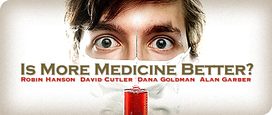I asked:
Do you claim the existence of identifiable treatments with positive benefits, which are cut when spending is cut, shows that aggregate spending variations do give substantial aggregate health gains?
Dana Goldman replied:
My response is yes. The research on the use of ACE inhibitors by diabetics is a good place to start, but there are many more drug therapies that qualify. And the reason the variations literature ignores it is because they look at treatment after a serious event occurred when many of the dollars are spent. Heart attacks are the canonical example. And price sensitivity is non-existent once you have had a heart attack. Raising patient cost-sharing will not affect whether the doctor does angioplasty or not, because any reasonable effort to apply prices will have a marginal cost of zero once a catastrophic cap is met.
Dana, since you did not mention the first or fifth options I offered, I’ll presume you grant that simple crude cuts would produce disturbances similar to those seen in aggregate studies, and that such aggregate studies appear, at least to the untrained eye, to show little relation between health variations and medical spending variations. So the question is: why exactly do you think aggregate studies are misleading?
You complain the variations literature ignores ACE Inhibitors “because they look at treatment after a serious event occurred.” Yes, such studies often focus on post-event variations, to better control for initial patient health variations, but many variation studies also consider completely aggregate health and medical spending. Could you explain why you think these other aggregate studies are misleading, in our usual statistics terminology? That is, for example, are specific important controls missing, are the models mis-identified, or is there publication selection bias? Also, if you accept the post-event results, then you should at least support crude cuts to reduce post-event spending.
And how could the existence of a few “identifiable treatments with positive benefits” be much evidence against the claim that extra medicine has roughly equal amounts of helpful and harmful medicine, relative to the claim that it has more helpful than harmful medicine. Perhaps if you had randomly sampled from possible treatments, then the fact that a sample turned out to be helpful might be weak evidence. But surely you aren’t claiming ACE inhibitors are randomly sampled.
Also, you complain the RAND HIE “was only for those with generous insurance, and it only applied to late 1970’s medical care.” But this at least suggests cutting spending for those with generous insurance, at least to the extent that the relative mix of helpful and harmful medicine has not changed. And what would be the evidence that this mix has changed? Again, it cannot simply be the existence of some known-to-be-helpful medicine, right?

